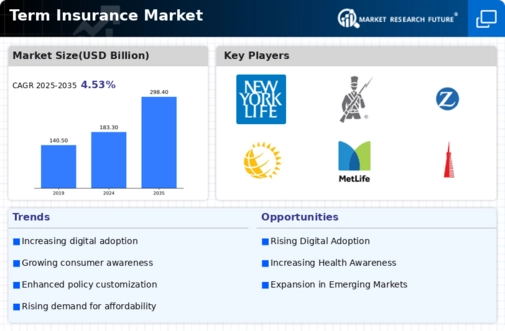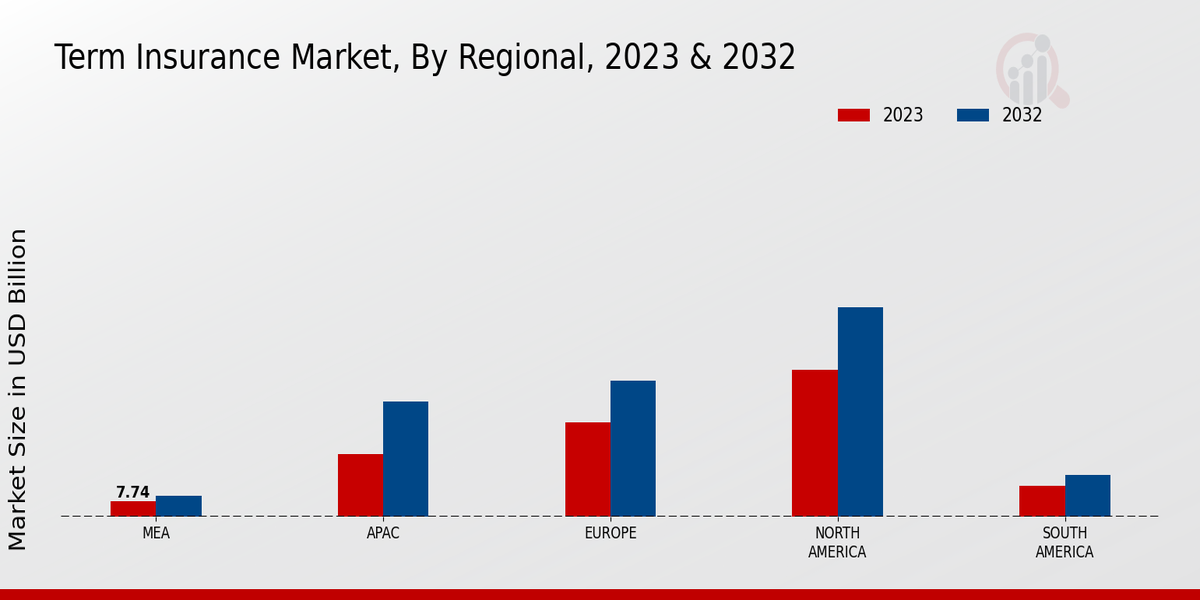Market Growth Projections
The Global Term Insurance Market Industry is poised for substantial growth, with projections indicating a market size of 183.3 USD Billion in 2024 and an anticipated increase to 298.4 USD Billion by 2035. This growth trajectory suggests a compound annual growth rate of 4.53% from 2025 to 2035. Various factors contribute to this optimistic outlook, including rising awareness of financial security, technological advancements, and demographic shifts. As the market evolves, it is likely to attract new entrants and foster innovation, further enhancing the range of products available to consumers.
Increasing Disposable Income
The rise in disposable income across various demographics is significantly influencing the Global Term Insurance Market Industry. As individuals' financial capabilities improve, they are more inclined to invest in term insurance policies to secure their families' futures. This trend is particularly pronounced in developing nations, where economic growth has led to higher income levels. The correlation between rising disposable income and increased insurance uptake suggests a promising outlook for the market. By 2024, the market is anticipated to reach 183.3 USD Billion, driven by this growing financial capacity among consumers who prioritize long-term financial planning.
Regulatory Support and Reforms
Regulatory support and reforms play a crucial role in shaping the Global Term Insurance Market Industry. Governments worldwide are implementing policies that promote transparency and consumer protection, thereby fostering trust in insurance products. Such regulations often encourage competition among insurers, leading to more favorable terms and pricing for consumers. In many regions, regulatory bodies are also advocating for increased insurance penetration, which is expected to boost the market's growth. As the industry adapts to these regulatory changes, the market is likely to experience a compound annual growth rate of 4.53% from 2025 to 2035, indicating a robust future for term insurance.
Rising Awareness of Financial Security
The increasing awareness of the importance of financial security among individuals is a key driver of the Global Term Insurance Market Industry. As people recognize the necessity of safeguarding their families' financial future, the demand for term insurance policies has surged. This trend is particularly evident in emerging economies, where a growing middle class seeks to secure their financial stability. In 2024, the market is projected to reach 183.3 USD Billion, reflecting this heightened awareness. Furthermore, educational initiatives by governments and financial institutions have contributed to this awareness, encouraging individuals to consider term insurance as a viable option for long-term financial planning.
Demographic Shifts and Aging Population
Demographic shifts, particularly the aging population, are reshaping the Global Term Insurance Market Industry. As life expectancy increases, there is a growing need for financial products that provide security during retirement years. Older individuals are more likely to seek term insurance to ensure their dependents are financially protected. This trend is evident in developed countries, where the proportion of elderly citizens is rising. Consequently, insurers are adapting their offerings to cater to this demographic, which is expected to drive market growth. The market's expansion is projected to continue, with estimates indicating a rise to 298.4 USD Billion by 2035.
Technological Advancements in Insurance
Technological advancements are transforming the Global Term Insurance Market Industry by enhancing the efficiency and accessibility of insurance products. Innovations such as artificial intelligence and big data analytics enable insurers to streamline underwriting processes, assess risks more accurately, and personalize policies for consumers. This shift not only improves customer experience but also reduces operational costs for insurers. As a result, the market is expected to grow significantly, with projections indicating a rise to 298.4 USD Billion by 2035. The integration of digital platforms allows for easier policy management and claims processing, further driving consumer interest in term insurance.
























Leave a Comment